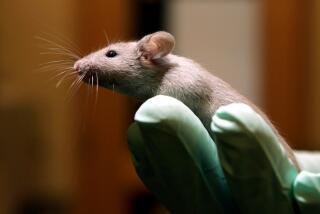Procedure May Give Fatherhood to Infertile Men
- Share via
A new procedure may enable thousands of infertile men to father children, even those who were “hopeless cases,” two nationally prominent fertility doctors announced in Orange County.
The men who can be helped, the doctors said, include those born without vas deferens, ducts that carry sperm from the testicles where it is manufactured. Such men can have normal sex but cannot impregnate.
The new procedure, which so far has no formal name, involves surgically removing sperm and combining it with the wife’s eggs. The resultant in vitro, or test tube, fertilization is then implanted either in the wife’s Fallopian tubes, where it travels to the uterus, or in the uterus directly where normal birth may proceed.
Vasectomy Cases
Dr. Ricardo H. Asch of the UC Irvine Center for Reproductive Health and Dr. Sherman J. Silber of St. Luke’s Hospital in St. Louis said in a joint interview that their newly developed procedure also promises help to thousands of men who have been unable to reverse vasectomies.
The two doctors said male infertility is partially or wholly responsible for up to 40% of infertility cases in the United States. This procedure, Silber said, brings hope to a “very major national problem.”
Twenty-five married couples from cities around the nation came to the UCI Center for Reproductive Health, 12555 Garden Grove Blvd., Garden Grove, two weeks ago to have Asch and Silber jointly perform the fertility operations. The doctors said the marathon operations were scheduled all in one week because the two usually are in different states.
“We don’t know what our ultimate success rate will be,” Silber said. “But we think it is a good procedure, and we are going to get a good success rate from it.”
The doctors’ first two cases, both involving men who had been born without vas deferens, resulted in pregnancies. Asch, 40, and Silber, 46, described the success of those operations in a letter published in the Oct. 10 edition of the Lancet, a British medical journal.
“The fact that the first two couples on whom this new treatment was tried have conceived suggests that we now have the means to help couples with otherwise poor prospects of having a family--namely, those where infertility is due to congenital absences of the vas,” said the doctors’ letter in the Lancet.
One of the pregnancies ended in a natural, spontaneous abortion, but the other mother is expected to deliver in May, the doctors said.
The two fertility specialists said that they started conferring about a year ago on how their specialties might be united to help solve male infertility.
Asch is nationally prominent for his work in developing an alternative form of test-tube fertilization called GIFT (gamete intrafallopian transfer). Silber is prominent in work with infertile men.
Silber said that men born without vas deferens nonetheless produce sperm. He said his previous operations, done through microsurgery, had proved that sperm from such infertile men could be removed. But the quality of the sperm made the success of direct implantation unlikely, Silber said.
In Vitro Fertilization
Thus, Silber said, the solution appears to be uniting the weak sperm with female eggs through in vitro fertilization. Asch’s work has made him an expert in this field, Silber said, so the two men teamed up last August for the first two operations.
“To make something like this happen, you need a multidisciplinary approach,” Asch said.
Success required expertise in urological microsurgery--which Silber provided--and expertise in removal and test-tube fertilization of eggs, which Asch and his associates provided. Asch said his associates, Dr. Jose Balmaceda and biologist Teri Ord, played major roles in the first successful operations.
The operation to remove sperm usually requires only a day in the hospital, the doctors said.
“I had told some of these men in the past that they should give up hope of having a baby and should adopt a child,” Silber said. “But now, with this procedure, we are able to get usable sperm from these hopeless cases. We’re able to get fertilization from sperm that seemed impossible.”
More to Read
Sign up for Essential California
The most important California stories and recommendations in your inbox every morning.
You may occasionally receive promotional content from the Los Angeles Times.













